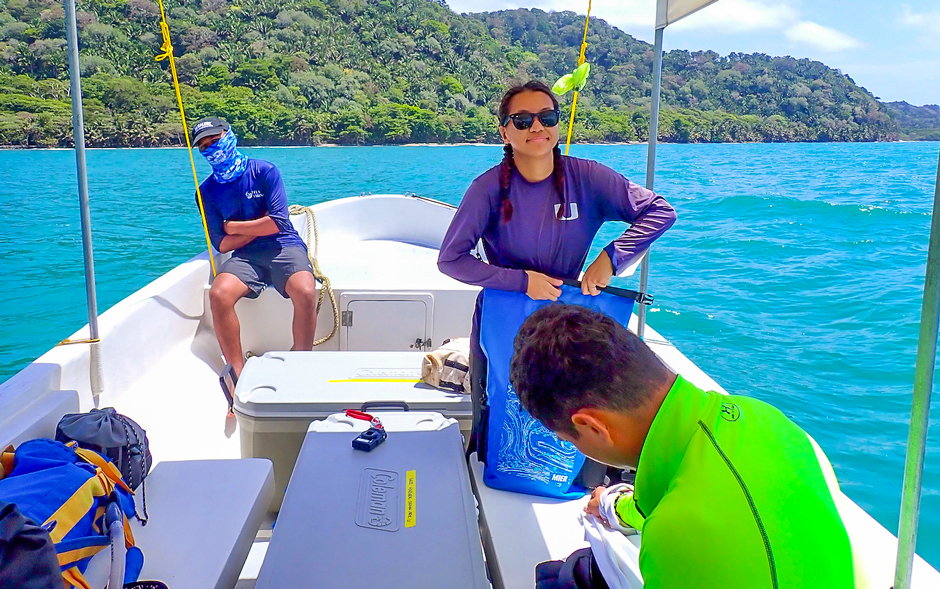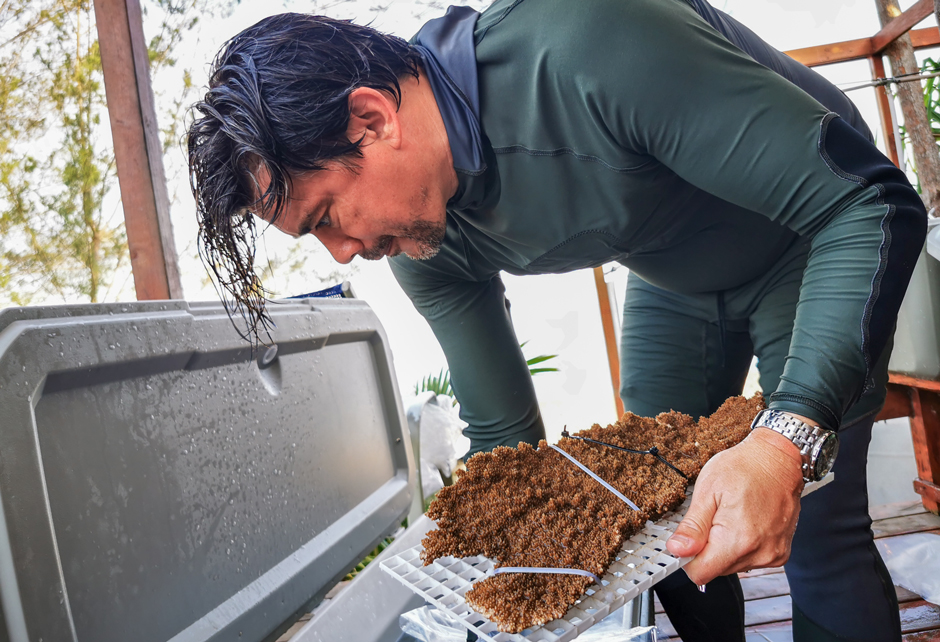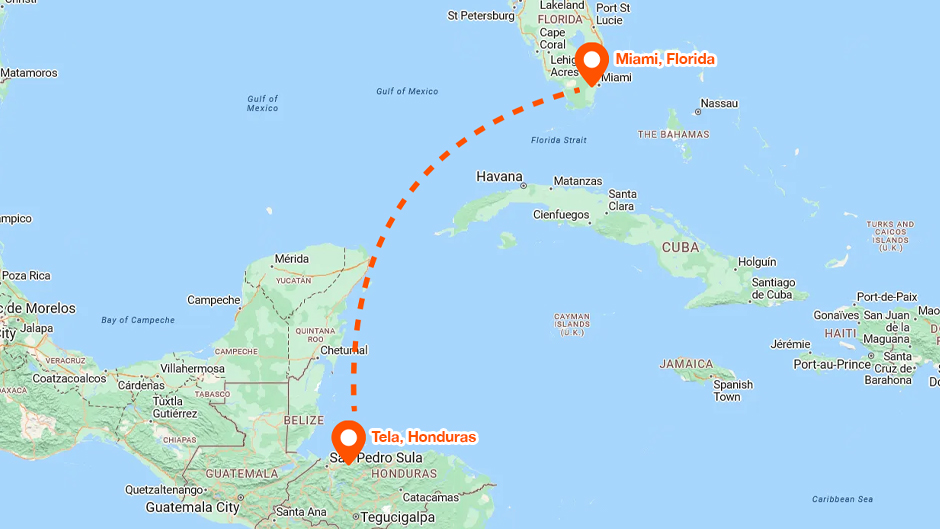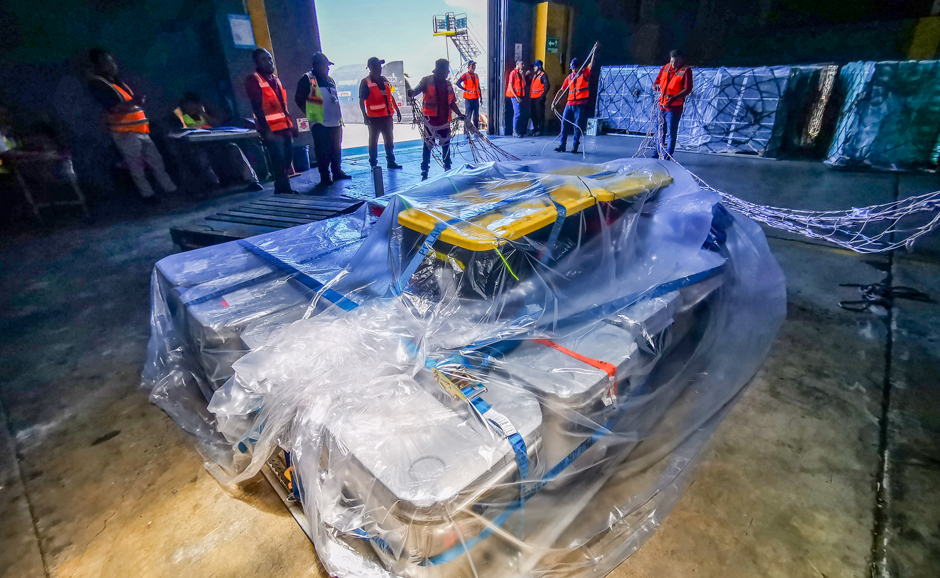It seemed like a mirage.
When Alexandra Wen arrived in Tela Bay, Honduras, and looked out at a massive expanse of spiky golden elkhorn corals just offshore, she was speechless.
It was a stark contrast from last summer, when Wen and her doctoral advisor, professor Andrew Baker, witnessed widespread coral bleaching across the Florida Keys and in Biscayne National Park. As oceans continue to warm and acidify across the globe, coral reefs are one of the first ecosystems to fall victim to the stressful water conditions.
As a result, the world's coral cover is diminishing at an alarming rate.
"To go from seeing the state of things in Florida to seeing an endless forest of elkhorn—it was really astonishing," said Wen, a University of Miami Rosenstiel School graduate student and coral researcher. "I've never seen that much elkhorn coral in one place."
Yet, in Tela Bay, where the water temperatures can reach 89 degrees or higher, and nearby rivers and lagoons dump fresh water and agricultural nutrients into the ocean, creating murky water, the reefs defy scientific explanation. Many coral species in Tela Bay are thriving, including large stands of elkhorn coral, which are critically endangered across the Caribbean.
And fragments and biopsies of these corals that the team recently brought back to Miami may help explain how corals can survive, and thrive, in warmer ocean waters. Hopefully, it will also allow Baker's Coral Reef Futures Lab to breed these with Florida corals to produce more heat-tolerant varieties.

"Last summer's bleaching event showed that Florida's elkhorn populations are struggling to deal with warming temperatures, so we hope that going further afield, to warmer places like Honduras, will help us produce the next generation of corals that will be able to deal with climate change," Baker said.
This is the elusive goal that Baker, a professor of marine biology and ecology at the Rosenstiel School of Marine, Atmospheric, and Earth Science, has been searching for to help restore coral reefs around Florida and the wider Caribbean.
"This is the first time that scientists have been able to import corals from very warm reefs overseas, with the goal of trying to breed those corals with Florida's corals, to create offspring that have increased heat tolerance," said Baker, who has been working to understand the biology of resilient corals for more than two decades.

A perilous journey
Although bringing the live coral colonies to Miami is a sign of major progress, it was not an easy path.
Baker first learned about Tela Bay, Honduras, almost two years ago, when he was introduced to Antal Borcsok, co-founder and CEO of Tela Marine, a local science organization on Honduras' mainland. After learning about the many challenges these reefs are able to overcome from Borcsok, Baker kept in touch with him and worked with officials at the Miami office of the U.S. Fish and Wildlife Service to get the proper permits to collect corals from Tela Bay. In turn, Borcsok and Gaby Ochoa, of the Roatan Marine Park in Honduras, helped him navigate the Honduran permitting process.
In late May, Wen, along with graduate students Fabrizio Lepiz Conejo, and Cailyn Joseph ventured to Honduras with Baker for a busy nine-day trip to identify and collect large coral fragments and biopsies from the bay.
In all, the team brought back 21 symmetrical and grooved brain corals from the middle of the bay, which was about 40 feet deep, along with 13 elkhorn coral fragments from shallower depths of about 10 feet. They also collected 367 tiny coral biopsies to help the lab learn about the genetic makeup of Tela Bay corals.
Officials at Miami-based Amerijet International Airlines helped Baker transport several coolers full of the corals on a cargo plane from San Pedro Sula to Miami, during a nerve-wracking 15-hour journey that started at 4 a.m. in Tela Bay and ended around 9 p.m. at the Rosenstiel School's fish and coral hatchery.
"We didn't know how the corals would fare on such a long journey, but the outcome is as good as we hoped for," Baker said. "And you only need a few of these colonies to produce millions of larvae, so we are very excited to have so many corals from Tela Bay here in Florida."
The Honduran coral fragments are now in specialized indoor tanks that mimic natural sun and moon cycles on the reef. Baker and his team are hopeful this will induce them to spawn, or release sperm and eggs, in the coming months. That may happen around late July through September, about a week after the full moon of each month, said Cameron McMath, facilities manager for the Coral Reef Futures Lab.

Expanding the effort
But Baker, who is working on several other collaborative coral research projects across the region, also decided to share some of the Honduran corals with The Florida Aquarium in Tampa. Keri O'Neil, director and senior scientist of the coral conservation program, is an expert in land-based coral spawning, and was thrilled to receive seven healthy elkhorn samples from Honduras. She is confident that they will likely spawn later this summer.
"We see signs of healing and growth already, and their polyps are extended and moving in the water, which is a sign of good health," she said.
O'Neil successfully bred the first elkhorn coral babies in human care at the aquarium's Apollo Beach lab a few years ago. However, many of the offspring that were planted in the ocean did not survive the heat of last summer. After learning about the conditions in Tela Bay, O'Neil is optimistic that offspring from the Honduran corals may fare better.
"These corals offer a new hope that we can build even stronger elkhorn coral populations that are able to be resilient against all the things that are happening in our oceans," she said.
Their success could help advance larger coral restoration projects, too. For example, Baker and O'Neil are working with experts across the nation on the X-Reefs project, funded by the U.S. Department of Defense. It focuses on using large-scale hybrid coral reefs—which combine natural and artificial solutions—to protect Florida's coastlines from storm surge and erosion. Producing heat-resilient corals would be critical, but elkhorn corals would be particularly helpful, since their structure helps diffuse wave energy.
Although permission was granted for importing coral brood stock into controlled land-based facilities, the planting of the offspring onto Florida's reefs will require additional approvals from state and federal authorities. This regulatory step is crucial to ensure the continuation of coral conservation and restoration efforts.
"If we are going to use corals to protect our coastlines, we can't just put out corals that are going to bleach the next time we have a really hot summer," Baker added. "We need to be engineering corals for a warmer Florida future."
For now, Baker and his team are focused on keeping the corals healthy so they will spawn later this summer or in the fall.
"If these Honduran parents spawn, I'm optimistic that we will be able to raise the offspring because we have already done it successfully with Florida's elkhorn corals," Baker said.







